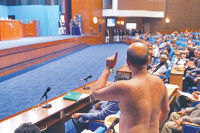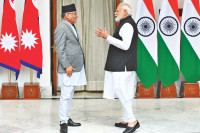Special Supplement
Why it’s unfair to overlook the economic achievements of Oli administration
Enter week 45. That’s how long the KP Oli-led government with the largest governing majority has been around for
Bhojraj Poudel
Enter week 45. That’s how long the KP Oli-led government with the largest governing majority has been around for. In the context of an agrarian society like ours, 45 weeks is more than enough time to plant and harvest rice, wheat, maize or any other crop. Given that, it is normal to have high expectations for dramatic improvements in living standards and advanced public service delivery mechanism, if these many weeks have elapsed from the calendar. Finally coming out of the political imbroglio, Prime Minister KP Oli took office with the promise of a ‘Prosperous Nepal, Happy Nepali’. Some lofty goals like getting high speed trains to connect Nepal latitudinally animated his promise. But since taking office in mid-February to come today, objectively speaking, it would be unfair to overlook some of the achievements of this administration.
Required but not sufficient
The idea of a prosperous Nepal captured every Nepali’s imagination. This was the government’s ticket to fame too. In just ten and a half months, the airport welcomed more than one million tourists. Finally, a long-standing goal has been achieved. Whether or not if we have been able to attract high-end tourists is a different story. Moving forward this year, the government proposed a slew of fiscal policy reforms in order to attract foreign direct investment (FDI) so that medium and large scale projects could be financed. Similarly, the government proposed to carry out development activities in line with the federal structure of governance. One of the major commitments of the budget speech for 2018-2019 was to focus on implementation of projects and programs instead of relapsing towards the tendency of distributing money for almost everything.
People’s expectations were enormous when the government was formed and they still are. In a way, the two-third mandate at the parliament for Nepal Communist party (NCP) was people’s clear message to the leadership that they had high expectations. To meet them they would fulfill, first, the condition of development—a stable government—put forward by NCP during the election campaign.
Unlike in the past, the 2018 budget was not loaded with populist policies. The finance minister’s main focus was on its implementability rather than making sweeping statements. However, this approach was not welcomed even by the members by his own ruling party. For years, the practice has been to present annual budgets that are more focused on pleasing certain groups or raising people’s expectations without having properly considered the economic foundation and sources of income. In terms of implementation of federalism and resource distribution, the government has developed a basic foundation through several steps such as developing formulas for revenue sharing and equalisation of grant. National Natural Resources and Fiscal Commission (NNRFC), a constitutional body, has not formed its full institutional shape but it has been functional. It has also been laying the foundation of resource management in the context of institutionalising and strengthening federalism in the country. Against this backdrop, the fiscal plan for 2018/19 is the first budget which captures the full spirit of federalism.
The government has made an instrumental social security scheme by introducing necessary regulations under the Social Security Act–2017. With the new arrangement for workers from various sectors—both private and public, the welfare scheme has the potential to change the whole dynamic of the labour market. Similarly, the government’s decision to move the Department of Revenue Investigation (DRI) under the Prime Minister’s Office (PMO) from Ministry of Finance (MOF) including a couple of other institutions created havoc at first, but it has bred positive results eventually. By reducing corruption, the move has made some positive impacts on governance. The Prime Minister Employment Program, which the government had allocated Rs3.10 billion has been materialised this year. Thanks to this scheme, youths have been able to take loans from commercial banks using their degree certificates as collateral. This has helped foster entrepreneurship among young people. Adding on, there has been slight improvement in doing business climate in the country too. As the government streamlined investments in the productive sector to facilitate financial markets, commercial banks started extending loans to the manufacturing industry and even start-ups. The steady rise in the numbers of forms being registered is a reflection of this. Hence, in the first four months of the fiscal year, the total number of registered companies has increased and reached to more than nine thousand.
The government has been successful in inking the Trade and Transit agreement with China. Though symbolic as of now, this agreement was particularly instrumental in that it has given a sense of trade diversification by reducing our traditional dependence on India. Over time, the signing of the Trade and Transit agreement is bound to pave the path for broader engagement with China. Undoubtedly, it will also open up many avenues, both economically and geopolitically. Yet, having said that, how much the government can engage with China by understanding Chinese methods of diplomacy still remains a critical issue.
Adjusting the indicators
Even looking at the basic macroeconomic indicators, such as revenue collection, investment in productive sectors and tourist inflow in the country seem pretty promising. Revenue collection has increased by 29.96 percent in the first trimester of the fiscal year, as compared to a 16.3 percent in the corresponding period of the last fiscal year. Further, commercial banks’ investment in the productive sector has increased by 24.62 percent in the first four months of the fiscal year. With these encouraging figures, the economic growth rate is projected to remain at 8 percent for this fiscal year.
Much has been done in the urban development front as well. The government is all geared up to develop two Urban Economic Corridors in the east and west in the next 10 years. Much ground work, such as the delineation of the urban economic corridor area in both sites, have been almost finalised. Many other urban development and solid waste management projects in different municipalities have been completed of which Dharan, Biratnagar, Butwal, Bhairahawa and Lumbini are thriving examples. Urbanisation has been growing at a rate of around 6 percent since 1970s. But to keep up the pace with this growth rate, there should be investments totaling $24.5 billion up to 2030. This itself is a challenge nonetheless.
One of the primary reasons why we have not been able to achieve the desired economic growth is because of low capital expenditure. In a bid to resolve this predicament, the government formed the Public Expenditure Review Commission. It is a special initiative to increase public expenditure by improving governance and other areas that have direct and indirect links to public expenditure. The commission has been working to identify the bottlenecks of public expenditure.
Critical policy reforms are underway. Homework is being done to table some new acts while old acts are being amended. The latter include the act governing mega-infrastructural development, the act related to public-private partnership (PPP) and investment, the procurement act and foreign exchange act. Similarly, the government is working on amending the Public Debt Management Act, Nepal Rastra Bank Act and Securities Board of Nepal Act in order to add vibrancy to the capital market and enhance the public debt management system. In the same vein, the government has already established a dedicated Public Debt Management Office (PDMO) under the Ministry of Finance bringing the office of debt management under one roof. This is expected to bring efficiency in debt management and improve the quality of management.
There are challenges in terms of improving public service delivery as the government has been working on managing human resources for all the three layers of the government. However, these tussles are a natural side effects of the gradual shifting from a unitary to federal system of administration—especially one where bureaucrats tend to be reluctant to go to places that they don’t find comfortable and see no incentive to stay there.
The list of things to get done and rightly is infinite to reach to the point of a prosperous Nepal but the sight is clear as we have reached to the lighthouse. Even double-digit growth rate is insufficient for us to become a middle-income country in the next ten years. Hence, the journey is longer than we have been assuming. Let’s cherish what has been done and keep adding bricks to the wall.
Poudel is an economist




 18.12°C Kathmandu
18.12°C Kathmandu










